Sage Rountree's Blog, page 11
December 31, 2024
The Most Painful and Productive Way to Improve Your Yoga Teaching
If you want to grow as a yoga teacher, the best tool is already in your hands—and it’s completely free. The catch? It’s a little uncomfortable at first.
The secret is simple: record yourself teaching. Whether you start with audio or dive bravely into video, reviewing your own teaching is the fastest way to improve.
why self-evaluation mattersAs yoga teachers, we’re often in our heads while teaching, focusing on cues, sequences, and students. Watching yourself on video or listening to an audio recording lets you step into the student’s perspective. You’ll quickly notice:
Verbal tics or filler words.Cues that might not land clearly.Volume problems.Pacing issues, like rushing or dragging.Uneven lengt hof holds between sidesThe beauty of this process is that it’s objective and actionable. Once you see or hear what isn’t working, you can fix it.
getting past the cringeI know: watching yourself on video can feel cringey at first. But the more you do it, the easier it gets. Start small. Record five minutes, listen back, and notice what you’re doing well. Celebrate those wins, and then look for opportunities to improve.
bonus: extra credit exercisesFollow along with your own video to feel what it’s like to be a student in your class.Transcribe your recording to analyze your word choice and phrasing.Run your transcript through a word cloud generator and see what you learn! Here’s what https://www.wordclouds.com made from my transcript of the Yoga Teacher Confidential podcast episode, S1E14, on this topic.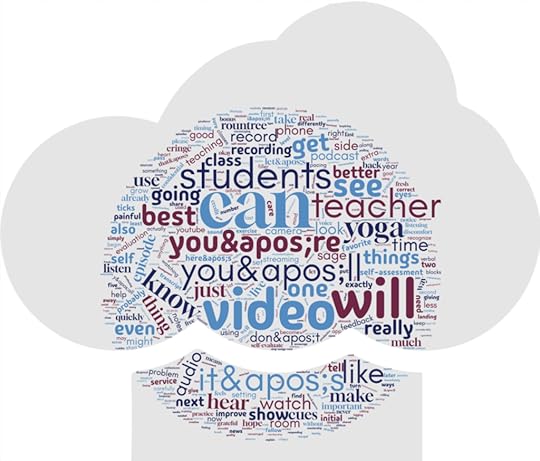
These steps take a bit more effort but offer deeper insights into your teaching style.
It’s not about perfection; it’s about progress. Taking the time to self-assess is one of the best gifts you can give your students—and yourself.
For more tools and exercises to grow as a teacher, read The Professional Yoga Teacher’s Handbook!
To hear more (the word cloud in action!), listen to Yoga Teacher Confidential wherever you get your podcasts (or right here):
listen nowOr watch the video on Spotify or YouTube:
The post The Most Painful and Productive Way to Improve Your Yoga Teaching appeared first on Sage Rountree.
December 28, 2024
Affirmation: I Refill My Well
Yoga teacher affirmation: I can’t pour from an empty cup. I refill my well.
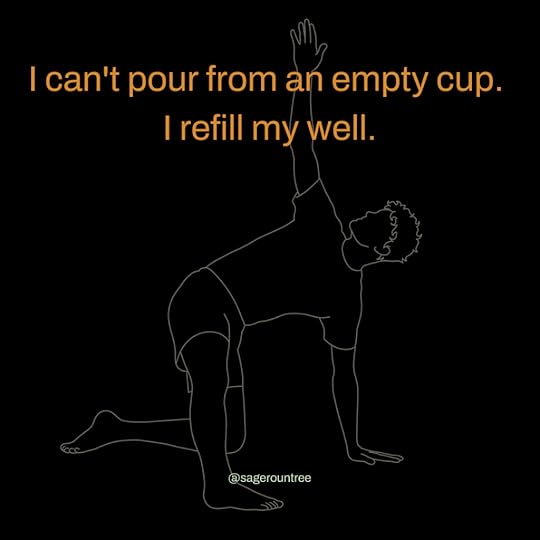
I recognize I must tend to myself so that I can give to my students. I discern between nerves and burnout, and I take steps to avoid overcommitment. I show up for my students grounded, centered, and rested.
The post Affirmation: I Refill My Well appeared first on Sage Rountree.
December 24, 2024
Managing Burnout as a Yoga Teacher
Feeling burnt out as a yoga teacher? You’re not alone. Teaching yoga is a rewarding career, but it can also be exhausting if you don’t care for yourself. Burnout doesn’t just affect you—it affects your students, too. When you’re drained, it’s hard to bring the energy and enthusiasm your students deserve.
Burnout is more than just fatigue. It’s a state of emotional, physical, and mental exhaustion caused by prolonged stress. The good news? There are ways to prevent it and recover from it.
burnout vs. nervesBefore a class, I feel a little nervous—that’s normal and even healthy! Nerves mean I care. The day I stop feeling them is the day I should retire.
But those jitters always fade once I’m teaching, and often the moment the first student arrives. If the dread or exhaustion sticks around, it might be burnout. Learning to distinguish between nerves and true burnout is an important first step in addressing the problem.
lessons from exercise physiologyAs a (retired) endurance sports coach, I know that stress and recovery go hand in hand. Athletes improve by balancing effort with rest. Yoga teaching works the same way. If you teach too many classes without downtime, you’ll eventually burn out. Finding the right balance for your schedule is key to longevity in your career.
practical tips to manage yoga teacher burnoutprioritize self-careTake a day off, step back from teaching, or treat yourself to something restorative.
optimize your scheduleStack classes to minimize transitions and give yourself more consistent time off.
set boundaries with your yoga studentsDon’t overextend yourself before or after class—your energy is valuable.
streamline your teachingRevisit sequences and themes to save time and mental energy. I’m here to help! The Art of Yoga Sequencing gives you lesson plans and a model for building your own without reinventing the wheel.
Consider dropping one or more classes and replacing them with workshops! The Workshop Workbook gives you everything you need to create sell-out workshops.
Taking care of yourself allows you to serve your students more effectively and enjoy your career for years to come.
ready to reclaim your energy?For more tips and tools to avoid burnout, check out:
The Art of Yoga Sequencing The Workshop Workbook The Athlete’s Guide to Recovery, 2nd ed. —my treatise on avoiding burnoutJoin the waitlist for my mentorship programYou deserve to feel inspired and energized in your teaching. Let’s make it happen.
for moreListen to S1E13 of Yoga Teacher Confidential, wherever you get your podcasts!
The post Managing Burnout as a Yoga Teacher appeared first on Sage Rountree.
December 21, 2024
Affirmation: I am in a healthy relationship with my students
Yoga teacher affirmation: I am in a healthy relationship with my students. I recognize that teaching yoga is a conversation, not a monologue—even though it can feel like one. I am a good conversation partner with my students. I listen more than I speak.
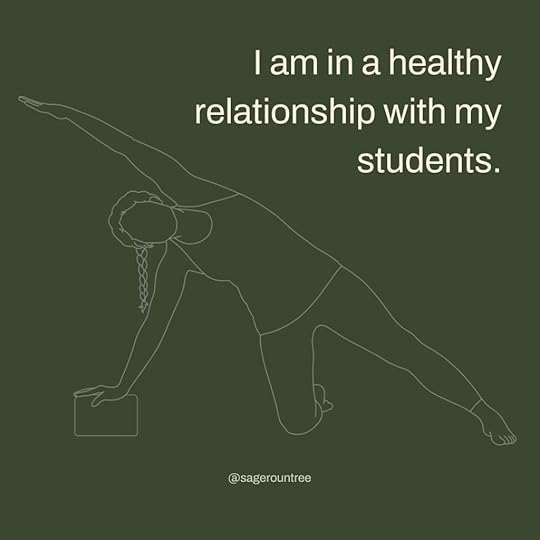
The post Affirmation: I am in a healthy relationship with my students appeared first on Sage Rountree.
affirmation: I am in a healthy relationship with my students
Yoga teacher affirmation: I am in a healthy relationship with my students. I recognize that teaching yoga is a conversation, not a monologue—even though it can feel like one. I am a good conversation partner with my students. I listen more than I speak.

The post affirmation: I am in a healthy relationship with my students appeared first on Sage Rountree.
December 17, 2024
Teaching Yoga Is a Conversation
Your yoga class isn’t a monologue. It might feel like one at times, but in reality, it’s a conversation. Even though your students may not be speaking aloud, they’re still responding—to your cues, your open-ended questions, and your overall energy in the room.
This idea—that teaching yoga is a conversation—has transformed the way I think about my classes. It’s helped me slow down, tune in, and connect more deeply with my students. Here’s how you can approach your teaching the same way.
hearing both sidesThe tricky part about this “conversation” is that, as the teacher, you only hear one side: your own. Your students’ responses are internal or expressed nonverbally. They show up in the vibe of the room, in subtle shifts in their bodies, and in their energy.
Once I embraced this, I realized I needed to give my students space to process. When I fill every moment with my voice or rush through sequences, I lose the conversational rhythm.
being a good conversation partnerSo, how can you make your teaching more conversational? Follow the same rules you’d use in any good dialogue:
Don’t make it all about you.Ask open-ended questions.Pay attention to nonverbal cues.Remember what students share and follow up next time.During class, it’s your turn to speak, but before and after class, listen. Say hello, ask about their day, and invite feedback on what they’d like to explore in future classes.
affirmation for connectionWhen I teach, I remind myself: “I am in a healthy relationship with my students.” This affirmation helps me show up with openness and curiosity, ready to connect with them in ways that go beyond words.
If you’re ready to deepen your connection with students, consider creating a workshop. Workshops invite more back-and-forth dialogue than a typical class, letting you hear directly from your students about their experience. Sign up for my free email course to learn how to design a workshop that truly resonates!
Tell me where to send the first lesson:
The post Teaching Yoga Is a Conversation appeared first on Sage Rountree.
December 14, 2024
Affirmation: Nerves Mean I Care
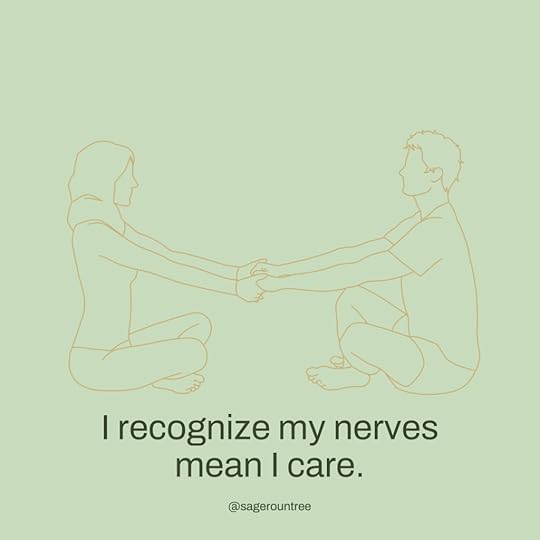
Yoga teacher affirmation: I view my nerves or any sense of imposter syndrome as a sign that I care deeply about yoga and how I can help my students.
For more:
Listen to S1E11 of the Yoga Teacher Confidential podcastRead “From Nerves to Confidence: Overcoming Imposter Syndrome as a Yoga Teacher”The post Affirmation: Nerves Mean I Care appeared first on Sage Rountree.
December 10, 2024
From Nerves to Confidence: Overcoming Imposter Syndrome as a Yoga Teacher
Do you feel your nerves bubbling up before teaching a yoga class? You’re not alone. I do, too!
Even seasoned yoga teachers feel the jitters. But instead of seeing them as a hindrance, you can learn to use those feelings to your advantage. Let’s explore how to transform nerves into confidence, tackle imposter syndrome, and show up fully for your students. (This is all covered in S1E11 of Yoga Teacher Confidential, too!)
why do we get nervous before class?Nerves are often seen as a negative force, but they can actually be a sign that you care. I always tell myself: “The day you stop feeling nervous is the day you should stop teaching.” Nervous energy shows that you’re invested in offering a meaningful experience to your students. And having some “arousal”—that is, some excited energy—is actually the key to peak performance.
understanding imposter syndromeImposter syndrome is a common challenge for yoga teachers, especially given the weight we attach to the ancient, spiritual roots of yoga and the responsibility we feel to honor its history. It’s normal to question your role as a guide, but dwelling on these doubts can keep you from serving the students who need your expertise.
how to overcome pre-class jitters1. redefine your relationship to nervesRecognize that nerves mean you care about your students and their journey. Shift your mindset from “I’m not ready” to “I’m excited to share something meaningful.”
2. know your scope of practiceAnxiety often stems from trying to be everything for everyone. Stay in your lane as a yoga teacher: offer guidance, hold space, and trust your students to make their own choices.
3. prepare thoughtfully but not excessivelyArriving at the studio with enough time to plan and center yourself can alleviate jitters. However, too much idle time can increase your anxiety.
4. ground yourselfA quick self-practice or breathwork session can help you feel more connected before stepping into the teaching seat.
a practical tip for high-pressure momentsWhether you’re teaching at a studio or in high-profile situations, focus on small tasks to manage nerves. Studio owners, for example, will deeply appreciate a quick blanket-folding session while you’re waiting for students to arrive. And routine can help you feel calm and controlled.
And remember: your students just want to feel better. Trust the practice.
Nerves and imposter syndrome don’t have to hold you back. When you embrace these feelings and shift your mindset, you can connect more deeply with your students and thrive as a teacher.
Listen to Yoga Teacher Confidential S1E11 for more!
Ready to reduce anxiety before your next class? Download my free back-pocket lesson plan to prepare with confidence. You’ll have one less thing to worry about!
let Sage plan your next class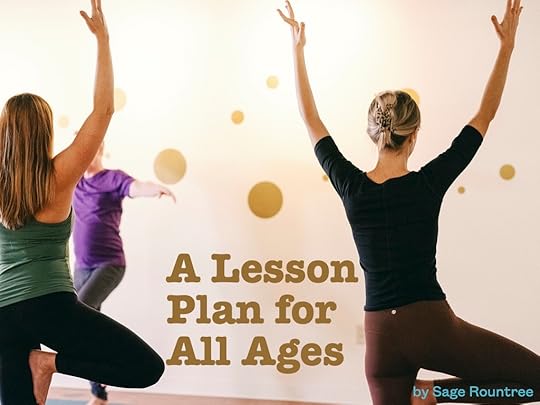
Feeling uninspired when it’s time to plan? I’m here to help!
Give me your email and I’ll send you my go-to class plan with ideas for every minute. This is the class I teach when my energy is low—but it’s the favorite of my students from 20 to 80 years old! I’ll even give you tips on how to adapt it for various class formats.
The post From Nerves to Confidence: Overcoming Imposter Syndrome as a Yoga Teacher appeared first on Sage Rountree.
December 7, 2024
Affirmation: I Help Students Solve Problems

Yoga teacher affirmation: I help students solve problems with yoga. I recognize this is the way to avoid suffering that is to come, and I carry this lesson to my students in classes and in workshops.
For more:
Lead Meaningful Workshops That Change Students’ Lives—and Your CareerYoga Teacher Confidential S1E10: Why Every Yoga Teacher Should Lead Workshops (Even Beginners!)The post Affirmation: I Help Students Solve Problems appeared first on Sage Rountree.
December 3, 2024
Why You Should Teach Yoga Workshops Now (Even if You’re New)
Most yoga teachers delay teaching their first workshop, believing they need more experience or expertise. But leading a workshop can be a game-changer—not just for your students, but for your growth as a teacher. If you’ve just completed your 200-hour training, workshops are a fantastic next step. Let’s explore why.
workshops offer depth and FocusIn a workshop, you’re not just running through a general class sequence. You have the opportunity to focus on one specific problem and provide tailored solutions through yoga. Whether it’s guiding students into a handstand, helping caregivers carve out self-care time, or relieving tightness in athletes, workshops allow you to zero in and make a meaningful impact.
And here’s the best part: workshops go beyond the mat. They often incorporate journaling, discussions, or mindfulness practices that bring fresh perspectives and deeper connections.
your fresh perspective is a strengthNewer teachers often feel like they lack the gravitas or experience to lead workshops. But your enthusiasm and relatability can be your superpower. You’ve likely just solved personal challenges with yoga, making your insights incredibly relevant to others. Plus, workshops help you refine your niche and build confidence quickly because they allow you to teach what you’re most passionate about in a concentrated, impactful way.
test, refine, and grow your ideasWorkshops are low commitment for both you and your students. You’re not asking for a long-term time slot or commitment; it’s a one-off opportunity to test ideas. The insights you gain from these sessions can inspire future offerings, deepen your expertise, and even lead to unexpected career breakthroughs.
For example, my early workshops teaching yoga to athletes helped me build a library of content that became the foundation of my first book deal. Your workshops could similarly open doors to writing, online courses, or other ventures.
workshops aren’t limited to the studioDon’t box yourself into the idea that workshops are in-person, weekend-only events. Think creatively:
Online workshops via live or recorded videoPrivate podcast episodes for niche audiencesAsynchronous video series for students to access on demandThese formats meet students where they are, making yoga more accessible while expanding your reach and income potential.
workshops create impact that lastsThink of workshops as feature films compared to the sitcom vibe of weekly classes. In a workshop, you can tell a complete story: introduce a problem, explore solutions, and guide students toward their resolution. Your students leave with tools they can use in their daily lives, creating lasting impact—and likely becoming regulars in your other classes and offerings.
lessons from my journeyWhen I started teaching workshops, I focused on yoga for athletes. My niche was clear, and I quickly became known as an expert in this area. Of course, not every workshop was perfect—like the time a participant critiqued my session for lacking clarity. That feedback stung but ultimately shaped how I structure my workshops today, ensuring clear takeaways and actionable next steps. (I talk about this in this episode!)
how to start teaching workshopsReady to design your own workshop? Here’s how:
1. Solve a specific problem: Identify a niche topic your students care about.
2. Create clear takeaways: Provide handouts, recordings, or action steps to help students integrate what they learn.
3. Gather feedback: Use feedback forms to iterate and improve each time you teach.
For a deeper dive, grab my free 5-lesson email course, or check out my Workshop Workbook—a step-by-step guide to planning, promoting, and refining your yoga workshops.
hear moreListen to S1E10 of Yoga Teacher Confidential to hear more!
listen hereThe post Why You Should Teach Yoga Workshops Now (Even if You’re New) appeared first on Sage Rountree.



